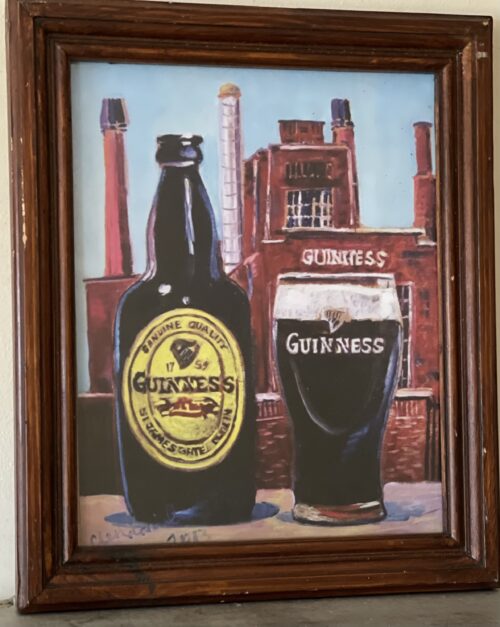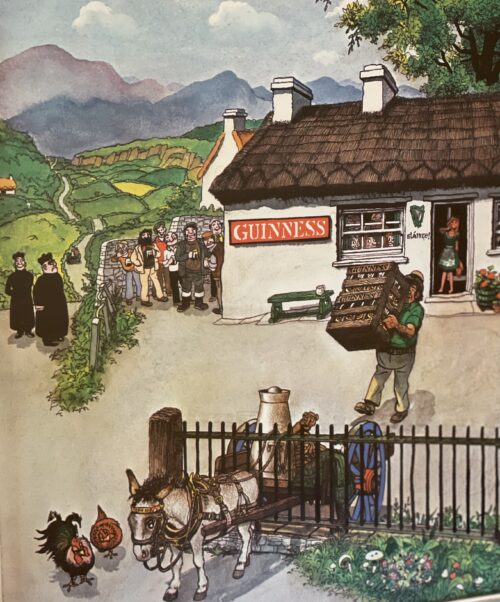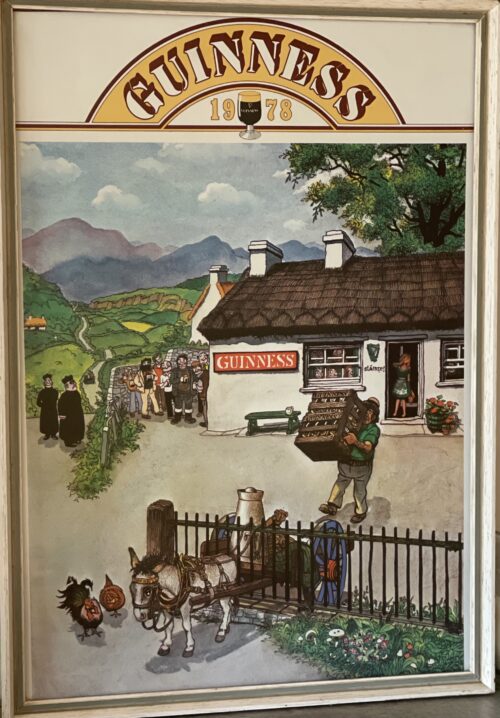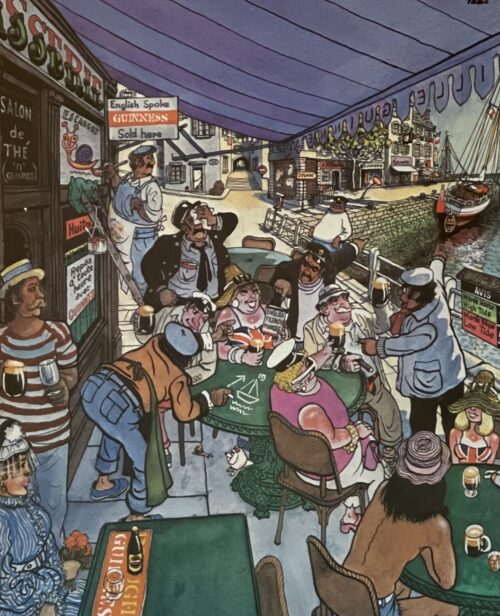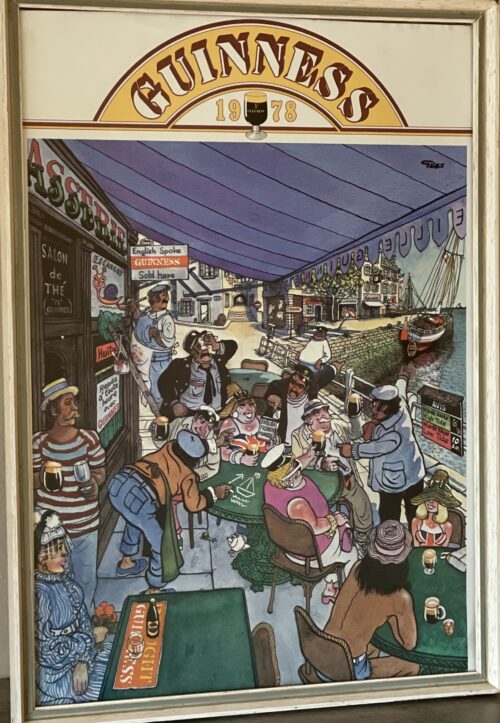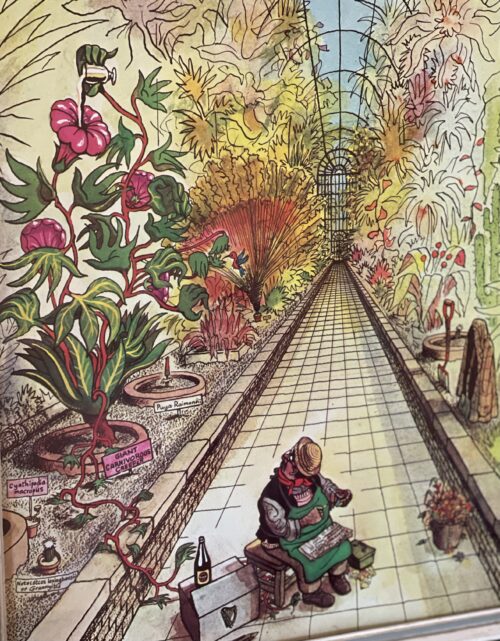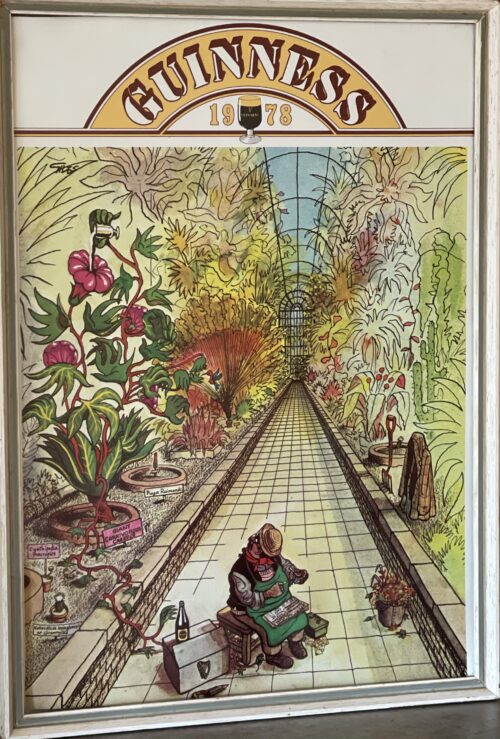The wonderful collection of cartoons crafted by the legendary artist Giles after being commissioned by Guinness for their 1978 Calendar.
Dimensions : 42cmx 30cm Dublin
Ronald "Carl" Giles OBE (29 September 1916 – 27 August 1995), often referred to simply as
Giles, was a
cartoonist best known for his work for the British newspaper the
Daily Express.

Giles's cartoons appeared in the
Daily Express newspaper and used his cartoon family to illustrate and comment on topics of the day. 'Grandma' seated with knitting appeared in November 1947.
His cartoon style was a single topical highly detailed panel, usually with a great deal more going on than the single joke. Certain recurring characters achieved a great deal of popularity, particularly the extended
Giles family, which first appeared in a published cartoon on 5 August 1945 and featured prominently in the strip. Of these, the most remembered is the enigmatic matriarch of the family, known simply as Grandma.
Another recurring favourite was Chalkie, the tyrannical school teacher who Giles claimed was modelled on one of his childhood teachers, and Larry, the mop-haired child from next door, often seen with a camera.
Early life
Giles was born in
Islington, London, the son of a tobacconist and a farmer's daughter. He was nicknamed "Karlo", later shortened to "Carl", by friends who decided he looked like
Boris Karloff, a lifelong nickname. He was actually registered with that name when he died in 1995. After leaving school at the age of 14 he worked as an office boy for Superads,
an advertising agency that commissioned animated films from cartoonists like
Brian White and Sid Griffiths' animation company also based in
Charing Cross Road, London from 1929. When Superads closed in 1931,
he gained experience in other small film companies in the area before being promoted to an animator in 1935, beginning to work for producer
Alexander Korda on a colour cartoon film,
The Fox Hunt. Giles then went to Ipswich to join
Roland Davies, who was setting up a studio to produce animated versions of his popular newspaper strip "Come On Steve". Six ten-minute films were produced, beginning with
Steve Steps Out(1936), but even though Giles was the head animator, he received no screen credit.
Career
In 1937, Giles started work as a cartoonist for the left-wing Sunday newspaper
Reynolds News, for which he drew a weekly topical cartoon and a comic strip, "Young Ernie". His strip came to the attention of the editor of the
Sunday Express and in 1943 he was interviewed for a job on the
Evening Standard, but was eventually offered a job on the
Daily Express and
Sunday Express instead, at a higher salary of 20
guineas per week, and he quit
Reynolds News. His first cartoon for his new employers appeared in the 3 October 1943 edition of the
Sunday Express.
Giles later said that he never agreed with the
Daily Express's politics, and felt guilt for abandoning the more left-wing
Reynolds News for it, but it made him wealthy: by 1955 he was being paid £8,060 per annum (equivalent to about £200,000 at 2018 prices) for producing three cartoons a week.

The Express cartoonist Giles sketches as Cromwell tank crewmen work on their vehicles, 1 May 1945.
Giles was rejected for war service for being blind in one eye and deaf in one ear following a motorcycle accident, but made animated shorts for the
Ministry of Information, while some of his cartoons were reprinted in poster form for the
Railway Executive Committee and others. In 1945 he became the
Daily Express's "War Correspondent Cartoonist" with the
2nd Army.
At one point during World War II he was assigned as War Correspondent to the
Coldstream Guards unit which liberated the
Bergen-Belsen concentration camp. Giles interviewed the camp commandant,
Josef Kramer, who turned out to be aware of and an admirer of Giles's work. Kramer gave Giles his Walther P38 pistol and holster, a ceremonial dagger, and his
swastikaarmband, in return asking for a signed original of Giles's work. Giles said:
- I have to say, that I quite liked the man. I am ashamed to say such a thing. But had I not been able to see what was happening outside the window I would have said he was very civilised. Odd, isn't it? But maybe there was a rather dishonourable reason. I have always found it difficult to dislike someone who was an admirer of my work. And strangely, Kramer was. I never sent him an original. What was the point? He had been hanged.
The pistol and armband as well as the whip carried by
Irma Grese were later given by Giles to a private collector in Suffolk.
In 1959 he was awarded an
OBE. Among his fans were the
British Royal Family, who often requested the originals of his work.
Giles's cartoons feature many references to news items, some even quoting a news headline.
The topics were typically British and made references to common British goods or attitudes. For example, a cartoon published in 1985 involves a
cleaner who has "left her box of
Persil just behind the throne" and knocks to be let back in to get it, upon which she is mistaken for
Black Rod.
Giles finally quit working for
The Daily Express in 1989; his cartoons had been allocated less and less space in the newspaper, and he said that the last straw was being stood up following a trip to London to lunch with the editor. He continued working for the
Sunday Express until 1991.
He never actually sold any of his creations, preferring to donate them to friends and to charitable organisations, like the
RNLI, of which he was Life President and which continues to issue charity Christmas cards each year bearing his work.
He also contributed cartoons to
Men Only and other publications, drew advertising cartoons for
Guinness,
Fisons and other companies, and designed Christmas cards for the
Royal National Institute for the Deaf and
Game Conservancy Research Fund.
Personal life
Giles married Sylvia 'Joan' Clarke, his first cousin, on 14 March 1942 in
East Finchley. The couple never had children but were married for over 50 years and shortly after their marriage the couple moved to
Witnesham, near
Ipswich,
Suffolk, where they spent the rest of their lives together. The last decade of Giles's life was plagued with failing health, including sight loss and encroaching deafness, and in 1990 he suffered the amputation of both legs due to poor circulation issues. He was reported to have never got over the death of his wife, on Christmas Day 1994, and died himself just over eight months later at Ipswich Hospital on 27 August 1995 aged 78.
Annual collections of cartoons
Collections of Giles's cartoons have been produced annually since 1946.
Up until the 50th collection (published in 1996), they were given the title "1st Series", "2nd Series", up to "60th Series" (2007), although since the 1997-published collection, they have been called "The 1998 collection", "The 1999 collection", etc. For reasons unknown the 2005 Collection was subtitled as Fifty-Sixth series, despite the 2003 edition being (correctly) titled as such and the 2005 release actually being the Fifty-Eighth book.
Until his death in 1995, Giles selected which cartoons would be in the annual.
Up until 1991, when Giles stopped producing new cartoons, the annual consisted of cartoons from the preceding year — for example, in the 42nd series (published in autumn 1989), the cartoons used were originally published in the
Daily Express and
Sunday Express between 30 June 1987 and 12 June 1988.
From 1991, the annuals consisted of cartoons previously published in collections, although some previously unpublished in annuals were included. The 46th series (1992), 47th (1993) and the 1999-2001 collections are all composed solely of cartoons which had not previously been published in any other collection. The 2002-2006 collections included some cartoons not previously published in any collections.
The 1999-2005 collections included a calendar, with 12 cartoons from the year's collection.
Most of the annuals included a foreword from an editor of the Express newspapers or a celebrity fan, including
Margot Fonteyn (ballet dancer),
Adam Faith (singer),
Spike Milligan (comedian), Sir
Malcolm Sargent (conductor),
Jim Clark (F1 champion),
Sean Connery (actor),
Frank Sinatra (singer) and
Tommy Cooper (comedian and magician).
The 2010 collection had an introduction about Giles, as it was the first year that
Hamlyn had published the collection (all previous collections had been published by
Express Newspapers). The 2011 collection returned to the tradition of having an introduction written by a celebrity fan (in that case,
Lee Latchford-Evans) and the majority of the cartoons featured in the 2011 collection had never previously appeared in an annual.
In June 2017, Dr Tim Benson published the first biography of Giles to be based on the cartoonist's own correspondence in his book 'Giles's War'. Benson discovered that Giles had been dishonest about his reasons for leaving Reynolds News due to the guilt he felt over joining Express Newspapers. The book also discusses how Giles misled his biographer Peter Tory over many details of his career.
Influences
Giles cited his influences as
Bruce Bairnsfather and
Graham Laidler ("Pont"), and he himself influenced the style of the newspaper cartoonists
"JAK" and "
Mac". Giles' cartoon 'Back to School Week' of 13 January 1953 inspired
Leo Baxendale to create the 'Bash Street Kids' for The Beano comic.
In April 2000, he was voted 'Britain's Favourite Cartoonist of the 20th Century'.
Tributes

Bronze statue depicting Giles's character "Grandma" in
Ipswich,
England. She stands looking up at the newspaper office window where Giles used to work.
A bronze statue depicting Grandma looking up at the newspaper office window in
Ipswich,
England where he used to work was unveiled by
Warren Mitchell. Giles, who was by this time using a wheelchair, was present at the unveiling.
He lived in
Witnesham and supported
Ipswich Town F.C.
Arthur Guinness started brewing ales in 1759 at the St James Gate Brewery,Dublin.On 31st December 1759 he signed a 9,000 year lease at £45 per annum for the unused brewery.Ten years later, on 19 May 1769, Guinness first exported his ale: he shipped six-and-a-half barrels to Great Britain before he started selling the dark beer
porter in 1778.
The first Guinness beers to use the term were Single Stout and Double Stout in the 1840s.
Throughout the bulk of its history, Guinness produced only three variations of a single beer type: porter or single stout, double or extra and foreign stout for export.
“Stout” originally referred to a beer’s strength, but eventually shifted meaning toward body and colour.
Porter was also referred to as “plain”, as mentioned in the famous refrain of
Flann O’Brien‘s poem “The Workman’s Friend”: “A pint of plain is your only man.”
Already one of the top-three British and Irish brewers, Guinness’s sales soared from 350,000
barrels in 1868 to 779,000 barrels in 1876.
In October 1886 Guinness became a public company, and was averaging sales of 1,138,000 barrels a year. This was despite the brewery’s refusal to either advertise or offer its beer at a discount.
Even though Guinness owned no
public houses, the company was valued at £6 million and shares were twenty times oversubscribed, with share prices rising to a 60 per cent premium on the first day of trading.
The breweries pioneered several quality control efforts. The brewery hired the statistician
William Sealy Gosset in 1899, who achieved lasting fame under the pseudonym “Student” for techniques developed for Guinness, particularly
Student’s t-distribution and the even more commonly known
Student’s t-test.
By 1900 the brewery was operating unparalleled welfare schemes for its 5,000 employees.
By 1907 the welfare schemes were costing the brewery £40,000 a year, which was one-fifth of the total wages bill.
The improvements were suggested and supervised by Sir
John Lumsden. By 1914, Guinness was producing 2,652,000 barrels of beer a year, which was more than double that of its nearest competitor
Bass, and was supplying more than 10 per cent of the total UK beer market.
In the 1930s, Guinness became the seventh largest company in the world.
Before 1939, if a Guinness brewer wished to marry a
Catholic, his resignation was requested. According to Thomas Molloy, writing in the
Irish Independent, “It had no qualms about selling drink to Catholics but it did everything it could to avoid employing them until the 1960s.”
Guinness thought they brewed their last porter in 1973.
In the 1970s, following declining sales, the decision was taken to make Guinness Extra Stout more “drinkable”. The gravity was subsequently reduced, and the brand was relaunched in 1981.
Pale malt was used for the first time, and isomerized hop extract began to be used.
In 2014, two new porters were introduced: West Indies Porter and Dublin Porter.
Guinness acquired the
Distillers Company in 1986.
This led to a
scandal and criminal trialconcerning the artificial inflation of the Guinness share price during the takeover bid engineered by the chairman, Ernest Saunders. A subsequent £5.2 million success fee paid to an American lawyer and Guinness director, Tom Ward, was the subject of the case
Guinness plc v Saunders, in which the House of Lords declared that the payment had been invalid.
In the 1980s, as the IRA’s bombing campaign spread to London and the rest of Britain, Guinness considered scrapping the Harp as its logo.
The company merged with
Grand Metropolitan in 1997 to form
Diageo.
Due to controversy over the merger, the company was maintained as a separate entity within Diageo and has retained the rights to the product and all associated trademarks of Guinness.

The Guinness Brewery Park Royal during demolition, at its peak the largest and most productive brewery in the world.
The Guinness brewery in
Park Royal, London closed in 2005. The production of all Guinness sold in the UK and Ireland was moved to
St. James’s Gate Brewery, Dublin.
Guinness has also been referred to as “that black stuff”.
Guinness had a fleet of ships, barges and yachts.
The Irish
Sunday Independent newspaper reported on 17 June 2007 that Diageo intended to close the historic St James’s Gate plant in Dublin and move to a greenfield site on the outskirts of the city.
This news caused some controversy when it was announced.The following day, the
Irish Daily Mail ran a follow-up story with a double page spread complete with images and a history of the plant since 1759. Initially, Diageo said that talk of a move was pure speculation but in the face of mounting speculation in the wake of the
Sunday Independent article, the company confirmed that it is undertaking a “significant review of its operations”. This review was largely due to the efforts of the company’s ongoing drive to reduce the environmental impact of brewing at the St James’s Gate plant.
On 23 November 2007, an article appeared in the
Evening Herald, a Dublin newspaper, stating that the Dublin City Council, in the best interests of the city of Dublin, had put forward a motion to prevent planning permission ever being granted for development of the site, thus making it very difficult for Diageo to sell off the site for residential development.
On 9 May 2008, Diageo announced that the St James’s Gate brewery will remain open and undergo renovations, but that breweries in Kilkenny and Dundalk will be closed by 2013 when a new larger brewery is opened near Dublin. The result will be a loss of roughly 250 jobs across the entire Diageo/Guinness workforce in Ireland.
Two days later, the
Sunday Independent again reported that Diageo chiefs had met with
Tánaiste Mary Coughlan, the deputy leader of the Government of Ireland, about moving operations to Ireland from the UK to benefit from its lower corporation tax rates. Several UK firms have made the move in order to pay Ireland’s 12.5 per cent rate rather than the UK’s 28 per cent rate.
Diageo released a statement to the London stock exchange denying the report.
Despite the merger that created Diageo plc in 1997, Guinness has retained its right to the Guinness brand and associated trademarks and thus continues to trade under the traditional Guinness name despite trading under the corporation name Diageo for a brief period in 1997.
In November 2015 it was announced that Guinness are planning to make their beer suitable for consumption by vegetarians and vegans by the end of 2016 through the introduction of a new filtration process at their existing
Guinness Brewery that avoids the need to use
isinglass from fish bladders to filter out yeast particles.
This went into effect in 2017, per the company’s FAQ webpage where they state: “Our new filtration process has removed the use of isinglass as a means of filtration and vegans can now enjoy a pint of Guinness. All Guinness Draught in keg format is brewed without using isinglass. Full distribution of bottle and can formats will be in place by the end of 2017, so until then, our advice to vegans is to consume the product from the keg format only for now.
Guinness
stout is made from water,
barley, roast malt extract,
hops, and
brewer’s yeast. A portion of the barley is roasted to give Guinness its dark colour and characteristic taste. It is
pasteurisedand
filtered.
Until the late 1950s Guinness was still
racked into wooden casks. In the late 1950s and early 1960s, Guinness ceased brewing cask-conditioned beers and developed a keg brewing system with aluminium kegs replacing the wooden casks; these were nicknamed “iron lungs”.
Until 2016 the production of Guinness, as with many beers, involved the use of
isinglass made from fish. Isinglass was used as a fining agent for settling out suspended matter in the vat. The isinglass was retained in the floor of the vat but it was possible that minute quantities might be carried over into the beer.
Diageo announced in February 2018 that the use of isinglass in draught Guinness was to be discontinued and an alternative clarification agent would be used instead. This has made draught Guinness acceptable to vegans and vegetarians.
Arguably its biggest change to date, in 1959 Guinness began using nitrogen, which changed the fundamental texture and flavour of the Guinness of the past as nitrogen bubbles are much smaller than CO
2, giving a “creamier” and “smoother” consistency over a sharper and traditional CO
2 taste. This step was taken after
Michael Ash – a mathematician turned brewer – discovered the mechanism to make this possible.
Nitrogen is less soluble than carbon dioxide, which allows the beer to be put under high pressure without making it fizzy. High pressure of the dissolved gas is required to enable very small bubbles to be formed by forcing the draught beer through fine holes in a plate in the tap, which causes the characteristic “surge” (the
widget in cans and bottles achieves the same effect). This “widget” is a small plastic ball containing the nitrogen. The perceived smoothness of draught Guinness is due to its low level of carbon dioxide and the creaminess of the head caused by the very fine bubbles that arise from the use of nitrogen and the dispensing method described above. “Foreign Extra Stout” contains more carbon dioxide, causing a more acidic taste.
Contemporary Guinness Draught and Extra Stout are weaker than they were in the 19th century, when they had an
original gravity of over 1.070. Foreign Extra Stout and Special Export Stout, with abv of 7.5% and 9% respectively, are perhaps closest to the original in character.
Although Guinness may appear to be black, it is officially a very dark shade of
ruby.
The most recent change in alcohol content from the Import Stout to the Extra Stout was due to a change in distribution through North American market. Consumer complaints have influenced recent distribution and bottle changes.
Studies claim that Guinness can be
beneficial to the heart. Researchers found that “‘
antioxidantcompounds’ in the Guinness, similar to those found in certain fruits and vegetables, are responsible for the health benefits because they slow down the deposit of harmful
cholesterol on the artery walls.”
Guinness ran an advertising campaign in the 1920s which stemmed from market research – when people told the company that they felt good after their pint, the slogan, created by
Dorothy L. Sayers–”Guinness is Good for You”. Advertising for alcoholic drinks that implies improved physical performance or enhanced personal qualities is now prohibited in Ireland.
Diageo, the company that now manufactures Guinness, says: “We never make any medical claims for our drinks.”
Origins : Dublin
Dimensions : 43cm x 35cm



















